A successful production of black tiger shrimp in the Philippines
Published: November 4, 2013
By: Henry David L. Fong (San
Miguel Foods, Inc. – BMEG Feeds Business Unit, Philippines), Patricio Raphael (INVE Aquaculture,
Philippines), Henry K. Young, Amelyn Bravo (HKY Industries, Inc,), Olivier Decamp (Inve Aquaculture,
Thailand) and Maryann Solis (Spectrum Biosolutions)
In this showcase in the Visayas, the collaborative efforts of a feed and aqua health team increased production at HKY Farm to 9.3 tonnes/ha.
The black tiger shrimp, Penaeus monodon industry in the Visayas province of the Philippines has faced several challenges over the last 4 years, from low farm gate price, White Spot Syndrome Virus and other disease outbreaks, deteriorating rearing environment, poor climatic conditions to increased production cost. This led to dramatic changes such as a shift in production from shrimp to tilapia and milkfish, the down-sizing of operations or even the closure of farms.
San Miguel Foods, Inc., a major player in the aquafeeds business, with an annual production of 150,000 tonnes in 2010, decided in late 2009 to establish a P. monodon shrimp showcase in Visayas province, and more particularly in Negros. The region was selected because the shrimp industry in the Negros which was once the centre of intensive black tiger shrimp production in the Visayas, experienced a decline, with nearly 30 farms active in 2008 and only 22 in 2010. Shrimp feed consumption reduced from an estimated 5,000 tonnes/year to 3,600 tonnes/year in 2010. It was a very dramatic year with a long dry spell caused by ‘El Nino’ and numerous disease outbreaks.
San Miguel Foods, Inc., a major player in the aquafeeds business, with an annual production of 150,000 tonnes in 2010, decided in late 2009 to establish a P. monodon shrimp showcase in Visayas province, and more particularly in Negros. The region was selected because the shrimp industry in the Negros which was once the centre of intensive black tiger shrimp production in the Visayas, experienced a decline, with nearly 30 farms active in 2008 and only 22 in 2010. Shrimp feed consumption reduced from an estimated 5,000 tonnes/year to 3,600 tonnes/year in 2010. It was a very dramatic year with a long dry spell caused by ‘El Nino’ and numerous disease outbreaks.
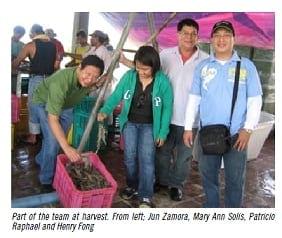
The company decided to evaluate an improved grow-out protocol at HKY Farm, located in Saravia in Negros Occidental. This shrimp farm is located between two large sugar mills and the incoming water is therefore affected by the sugar plantation run-offs and the heavy silt deposit. In the period 2008-2009, HKY operated only 6 ponds, with an average production of 7.2 tonnes/ha/crop. Following this collaboration, the production increased to 7 ponds, with a production level of 9.3 tonnes/ha/crop.
HKY farm
The improved production protocol was evaluated between the second quarter of 2010 and the first quarter of 2011, during the ‘El Nino’ season. This was a challenging period characterised by long dry spells and very high water temperatures. Towards 2011, black tiger shrimp production in the whole Visayas province declined by 21% (i.e. 3,401 tonnes) from a production of 4,300 tonnes in 2009 (B.A.S, Bureau of Animal Statistics, 2011).
HKY farm
The improved production protocol was evaluated between the second quarter of 2010 and the first quarter of 2011, during the ‘El Nino’ season. This was a challenging period characterised by long dry spells and very high water temperatures. Towards 2011, black tiger shrimp production in the whole Visayas province declined by 21% (i.e. 3,401 tonnes) from a production of 4,300 tonnes in 2009 (B.A.S, Bureau of Animal Statistics, 2011).
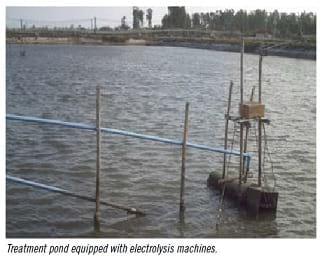
At the HKY farm, the incoming water is pumped to a 1.2 ha settling pond, stocked with tilapia, mangrove snapper and milkfish, and kept for 3 days maximum, before being pumped to a 1 ha treatment pond equipped with electrolysis machines. Electrolysis in saline water produces chlorine, with a salinity of 20 to 25 ppt sufficient for the production of 11 to 12 mg/litre of chlorine (Chanratchakool, 1991).
Each electrolysis machine consists of two electrodes of titanium-based material that are submerged 1 m into the water, but without touching the pond bottom. Typically, 6 electrolysis machines are installed for the 1 ha treatment pond, with a maximum of 6 paddle wheel aerators placed in the treatment pond to stimulate water circulation. Water is ready for use 24 to 36 hours after electrolysis.
Shrimp was fed an enhanced diet, BMEG CE-90 with astaxanthin. This feed is manufactured and marketed in the Philippines by the feeds and livestock division of San Miguel Foods, Inc. This is a subsidiary of the Philippine food and beverage giant, San Miguel Corp. The feed is formulated for semi-intensive and intensive black tiger shrimp production, highlighted by good survival rates and good feed efficiencies.
Each electrolysis machine consists of two electrodes of titanium-based material that are submerged 1 m into the water, but without touching the pond bottom. Typically, 6 electrolysis machines are installed for the 1 ha treatment pond, with a maximum of 6 paddle wheel aerators placed in the treatment pond to stimulate water circulation. Water is ready for use 24 to 36 hours after electrolysis.
Shrimp was fed an enhanced diet, BMEG CE-90 with astaxanthin. This feed is manufactured and marketed in the Philippines by the feeds and livestock division of San Miguel Foods, Inc. This is a subsidiary of the Philippine food and beverage giant, San Miguel Corp. The feed is formulated for semi-intensive and intensive black tiger shrimp production, highlighted by good survival rates and good feed efficiencies.
Managing conditions
Some of the culture management protocols include the following. Agri-lime and dolomite were applied according to water parameter conditions. Dolomite was also applied on pond and dykes after heavy rainfall or during acid sulfate leaching from the dykes. INVE aquaculture health products were used to manage the water and pond bottom quality, control pathogens and boost the immune system of shrimp during challenge. These include Sanocare PUR at 0.3 to 0.5 ppm. In case of a major challenge, the dose is increased to 1 ppm to control high readings of Vibrio in the water during shrimp culture. As shown in Figure 1a and b, the addition of this health care product leads to a reduction in Vibrio concentration (yellow colonies, green colonies and luminescent colonies), both in the pond water and in the shrimp.
Some of the culture management protocols include the following. Agri-lime and dolomite were applied according to water parameter conditions. Dolomite was also applied on pond and dykes after heavy rainfall or during acid sulfate leaching from the dykes. INVE aquaculture health products were used to manage the water and pond bottom quality, control pathogens and boost the immune system of shrimp during challenge. These include Sanocare PUR at 0.3 to 0.5 ppm. In case of a major challenge, the dose is increased to 1 ppm to control high readings of Vibrio in the water during shrimp culture. As shown in Figure 1a and b, the addition of this health care product leads to a reduction in Vibrio concentration (yellow colonies, green colonies and luminescent colonies), both in the pond water and in the shrimp.
The farm also uses the probiotic (Sanolife PRO-2) that is coated on the feed at a rate of 2-4 g/kg, with the purpose of promoting healthy gut microflora, leading to improved food digestion and feed conversion. This and a mixture of immunostimulants and neutraceuticals (Sano TOP S) are top dressed on feeds at a rate of 510 g/kg. During periods of disease challenge and poor weather conditions, these top-dressed feeds are applied simultaneously during incidence of white faeces, and high Vibrio concentration in the shrimp. The Vibrio count in the white faeces can reach up to 108 cfu/g. The inclusion of selected probiotics in the feed helps by preventing the colonisation of the shrimp’s gastrointestinal tracts by Vibrio. It also helps in fighting the Vibrio that would be present in the faeces that are released in the pond. As previously reported in Brazil, Bacillus are recovered in high concentration in the faeces of shrimp that received the probiotic treated feed.
In addition, Sanolife PRO-W is used for waste degradation, ammonia and sulphide control and maintenance of a stable algal bloom. It is applied at a rate of 100-200 g/ha. In cases of elevated levels of ammonia and sulphide, 10-35 kg of Sanolife Nutrilake was mixed with 100-200 g of Sanolife PRO-W, and broadcasted on areas with high accumulation of sludge, such as in the corners and centre of the pond. The former is a natural source of sodium nitrate that maintains the oxidation level of the pond sediments while supporting the metabolism of the Bacillus strains from the water treatment probiotic. The synergistic action prevents the formation of sulphide and other reduced chemicals.
In addition, Sanolife PRO-W is used for waste degradation, ammonia and sulphide control and maintenance of a stable algal bloom. It is applied at a rate of 100-200 g/ha. In cases of elevated levels of ammonia and sulphide, 10-35 kg of Sanolife Nutrilake was mixed with 100-200 g of Sanolife PRO-W, and broadcasted on areas with high accumulation of sludge, such as in the corners and centre of the pond. The former is a natural source of sodium nitrate that maintains the oxidation level of the pond sediments while supporting the metabolism of the Bacillus strains from the water treatment probiotic. The synergistic action prevents the formation of sulphide and other reduced chemicals.
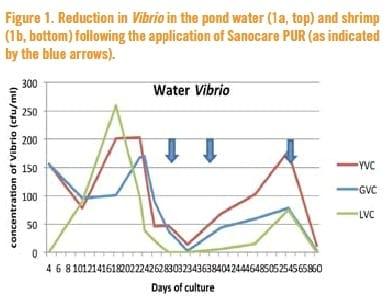
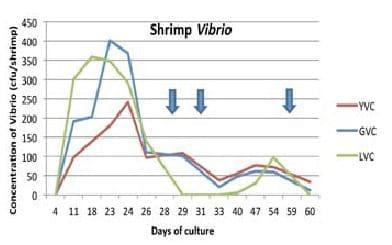
The performance of the protocol was evaluated at two stocking densities 15 PL/m2 and 22.5 PL/m2.
Showcase conditions
All ponds used for the showcase project were well prepared, with a good soil profile: organic matter contents of 0.4% to 1.0%, slightly alkaline soil pH of 7.55 to 8.35 and low level of available iron in the range of 216 to 673 ppm. However, ponds stocked at reduced stocking density did not necessarily perform better than those stocked at 22.5 PL/m2. The recommended pond management protocol led to a successful harvest, with USD 4.31 profit per kg of shrimp produced (Table 1).
Showcase conditions
All ponds used for the showcase project were well prepared, with a good soil profile: organic matter contents of 0.4% to 1.0%, slightly alkaline soil pH of 7.55 to 8.35 and low level of available iron in the range of 216 to 673 ppm. However, ponds stocked at reduced stocking density did not necessarily perform better than those stocked at 22.5 PL/m2. The recommended pond management protocol led to a successful harvest, with USD 4.31 profit per kg of shrimp produced (Table 1).
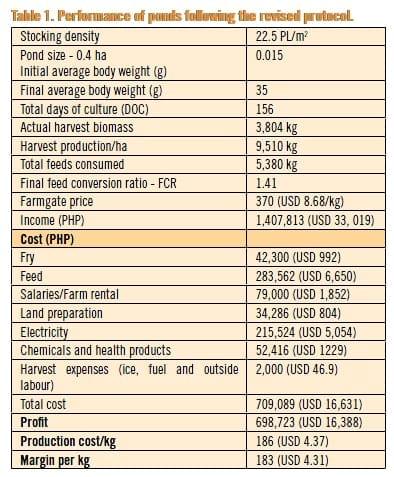
The electrolysis machines performed well in water with low suspended solids. Problems with the electrolysis are encountered in the presence of high suspended solids binding the chlorine or during high rainfall leading to a reduction in salinity and a lower production of chlorine. The application of 1ppm Sanocare PUR was adequate to control the Vibrio concentrations.
Combating slow growth
The study showed that in the event of slow growth, the best option is to maintain optimal shrimp health so that the growth delay could be recovered once growth conditions improve. The shrimps fed with CE-90 shrimp feed enhanced with astaxanthin showed superior survival rates (>90%) despite the severe environmental and disease challenge. If this approach had not been undertaken, the weaker shrimp would have been more sensitive to pathogens and disease outbreaks could easily occur.
The periodic weight gain was not necessarily directly related to feed uptake. Growth is always influenced by factors such as fry quality, feed quality, shrimp health status, environmental conditions and stress factors. These have to be considered when analysing the results. As suggested by the GOAL 2011 survey, the mood among shrimp actors from the Philippines is quite optimistic, with the majority believing that the global shrimp market will strengthen in 2012. Thus the knowledge acquired during this showcase can be applied to other species, such as P. vannamei shrimp, milkfish, pangasius and African catfish.
Reference
Goal 2011 (http://www.gaalliance.org/update/GOAL11/DiegoValderrama.pdf).
The study showed that in the event of slow growth, the best option is to maintain optimal shrimp health so that the growth delay could be recovered once growth conditions improve. The shrimps fed with CE-90 shrimp feed enhanced with astaxanthin showed superior survival rates (>90%) despite the severe environmental and disease challenge. If this approach had not been undertaken, the weaker shrimp would have been more sensitive to pathogens and disease outbreaks could easily occur.
The periodic weight gain was not necessarily directly related to feed uptake. Growth is always influenced by factors such as fry quality, feed quality, shrimp health status, environmental conditions and stress factors. These have to be considered when analysing the results. As suggested by the GOAL 2011 survey, the mood among shrimp actors from the Philippines is quite optimistic, with the majority believing that the global shrimp market will strengthen in 2012. Thus the knowledge acquired during this showcase can be applied to other species, such as P. vannamei shrimp, milkfish, pangasius and African catfish.
Reference
Goal 2011 (http://www.gaalliance.org/update/GOAL11/DiegoValderrama.pdf).
Acknowledgement
This article was originally published in the AQUA Culture Asia Pacific Magazine. May/June 2013 Edition. Engormix thanks for this huge contribution.
Related topics
Authors:
Join to be able to comment.
Once you join Engormix, you will be able to participate in all content and forums.
* Required information
Would you like to discuss another topic? Create a new post to engage with experts in the community.
Create a postINVE Aquaculture
13 de marzo de 2017
Hello Igor. Can you tell me more about the project? here a publication on culture of P. monodon in floating cage:
https://www.researchgate.net/publication /304656912_Experimental_culture_of_black_tiger_shrimp_ Penaeus_monodon_Fabricius_1798_in_open_sea_floating_cage
INVE Aquaculture
5 de mayo de 2016
Hello. Thank you for your message. You may find some interesting info in the following publications:
https://www.researchgate.net/publication/228051497_Rearing_of _Penaeus_monodon_Fabricius_postlarvae_in_floating_cages_at_different _stocking_densities
http://archimer.ifremer.fr/doc/2008/publication-4363.pdf
INVE Aquaculture
15 de octubre de 2015
Thank you for your message. We have various protocols that can be applied in extensive and semi-intensive farming. Could you please send me you coordinates and I would put you in contact with our commercial people for the Philippines.
INVE Aquaculture
3 de agosto de 2015
Dear Marlon. Thank you for your message. Could you please send me an email (o.decamp@inveaquaculture.com) with your full contact details. Best regards,
Olivier
INVE Aquaculture
13 de enero de 2014
Thank you for your message, Wendelio.
Let's discuss it by email. My contact is o.decamp@inveaquaculture.com
Regards,
Olivier
10 de abril de 2021
Do you have farm gate prices of black tiger prawn in the Phillipines in 2010 to 2015
10 de marzo de 2017
i would like to know if possible growout of Black Tiger prawns will be on the sea close enough to the shore.
CBF Consulting
21 de noviembre de 2015
I have a buyer for 25 tons a month for tiger prawns. Interested to know where to source this requirement.





.jpg&w=3840&q=75)


.jpg&w=3840&q=75)